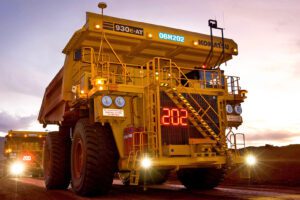Every year, there are around two recorded explosions at opencast mining operations caused by lightning strikes during blasting activities.

If lightning strikes a blast area that has been charged, it can cause the explosives to detonate which can injure those nearby or damage neighbouring structures. But the most serious consequence of lightning strikes at opencast mining sites is risk to life, as surface mining takes place in the open.
Storm smashes BHP’s Peak Downs mine
Lightning majorly impacts on productivity, and false alarms can cause the unnecessary clearing of a pit. Therefore, the installation of a lightning warning system is needed, say meteorological equipment specialists Biral.
Workplaces need to have safe procedures and systems in place to minimise the risk of injury to employees from the hazards that come with an electrical storm, and for this reason and the dangers facing other industries, Biral has developed its BTD-200 lightning detector.
The BTD-200 lightning warning system gives advanced warning of overhead lightning risk using its professional-grade detection system which is designed for the industrial and leisure industries. Aside from sites like golf courses and open-air venues, this also includes mines and petrochemical sites, whose businesses can be hugely affected by adverse weather conditions.
In mines all over the world, policies are in place to ensure the safety of the people on the sites each day. If lightning is close by, some mining operations must be stopped, causing a loss in production. An example of the disruption severe lightning can cause is when a strike destroyed four of the eight gas turbine generators at Porgera JV mine in Papua New Guinea, shutting down 50% of electrical power for more than three months at a production loss of $750,000 a day back in 2006.
In the majority of applications, the lightning warning system is used to help protect people and equipment from the dangers of a lightning strike by providing advanced warning of a storm’s approach. This is all the more important in areas where large numbers of people are outside across a wide area (such as an open mine). Systems which rely on lightning detection alone are only effective if the storm is already producing lightning at some distance before moving closer towards the detector. If the first lightning strike of the storm is overhead, then these types of systems give no advanced warning and therefore no protection.
The BTD-200 lightning warning system is a complete detection and warning system which has been developed from the Biral range of professional aviation grade lightning detection systems. It reliably detects the local presence of all forms of lightning out to a range of 35km (22 miles) from the sensor. Designed to be installed and set up by non-technical staff, it comes with a power supply and the essential PC application ‘Lightning Works’, for monitoring and warning personnel of approaching thunderstorms. The optional ‘Lightning Works Messenger’ application then works seamlessly with Lightning Works and automatically sends out email and SMS text messages to any number of site managers and remote staff.
The Lightning Works software alerts the staff and managers to threats in real time, allowing them to review and manage the situation and to alert staff to the potential danger. It can also activate warning sounders automatically if required.
Read more Mining Safety News














Add Comment